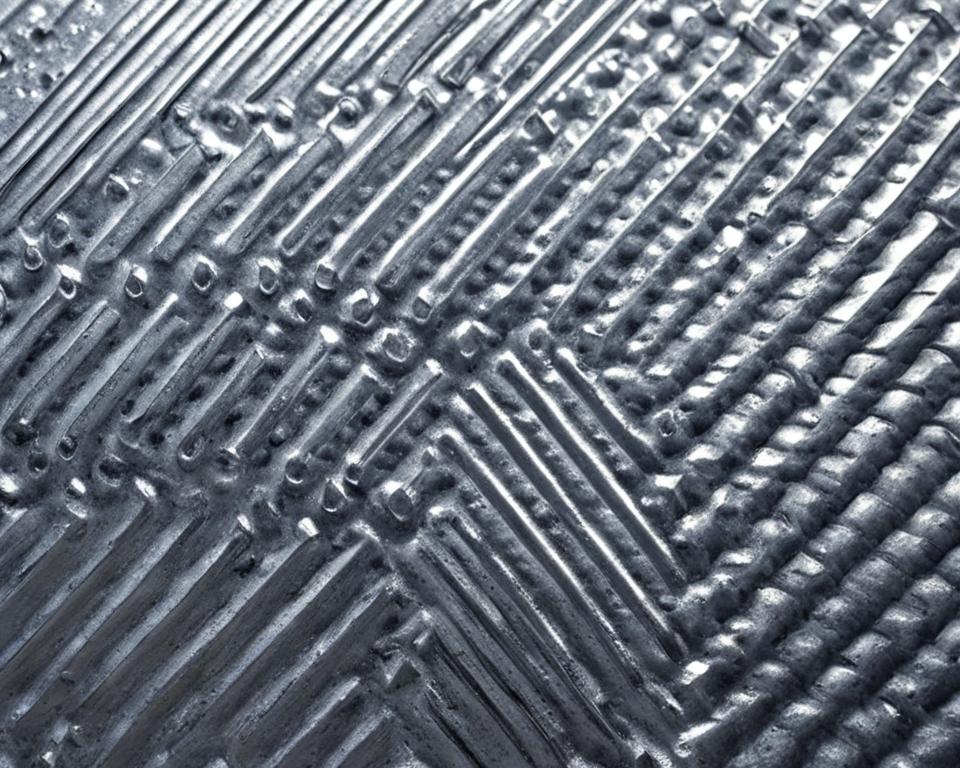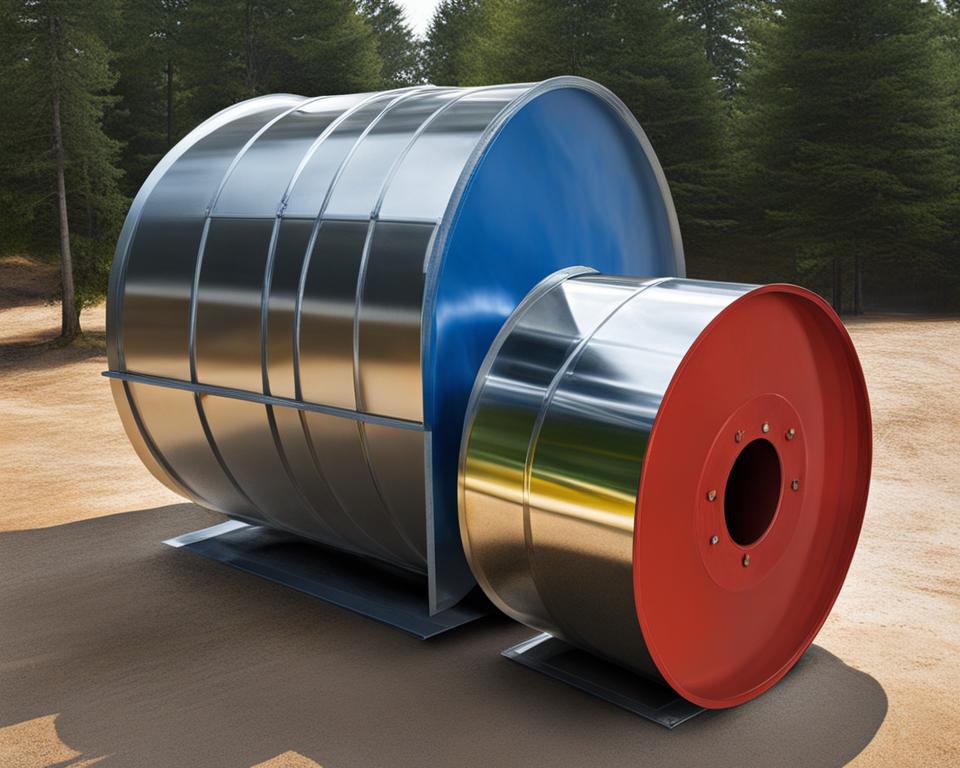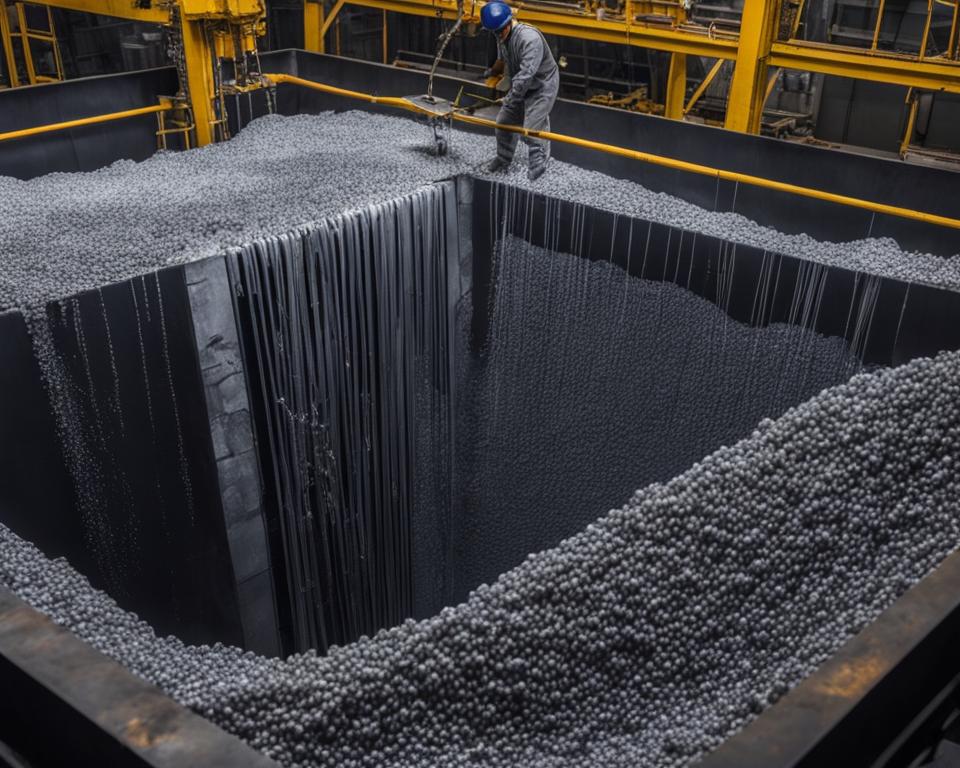Galvanizing is a process where steel or iron is coated with zinc to protect it from corrosion. Galvanized steel, also known as galvanized coating, is widely used for its rust-resistance and affordability. There are various galvanizing methods, with hot-dip galvanizing being the most common. In this article, we will compare hot dipped galvanized and galvanized steel, and explore their galvanization process.
Key Takeaways:
- Galvanized steel is zinc-coated steel and is highly resistant to rust.
- Hot-dip galvanizing is the most popular method of galvanization.
- Hot-dipped galvanized steel offers improved durability and versatility.
- Galvanization provides corrosion resistance for steel exposed to the elements.
- Hot-dip galvanized steel is a cost-effective choice for various industries.
Benefits of Galvanized Steel
Galvanized steel is a popular choice in various industries due to its rust-resistant properties, affordability, and durability. Unlike other types of treated steels, galvanized steel offers excellent resistance to rust and corrosion, making it suitable for applications exposed to moisture or the elements.
One of the major advantages of galvanized steel is its long lifespan. In temperate environments, galvanized steel can last for up to 50 years without requiring maintenance or refinishing. Even in severe weather conditions, it remains durable for over 20 years. This longevity makes it a cost-effective choice for a wide range of projects, whether it’s construction, automotive manufacturing, agricultural equipment, or solar structures.
Key Benefits of Galvanized Steel:
- Rust resistance: Galvanized steel is highly resistant to rust and corrosion, providing reliable protection for various applications.
- Affordability: Compared to other treated steels, galvanized steel is more affordable, making it a cost-effective option without compromising on quality.
- Durability: Galvanized steel has proven durability, making it suitable for long-lasting structures and equipment that can withstand harsh environmental conditions.
Galvanized steel’s corrosion resistance and longevity make it a preferred material in industries such as agriculture, automotive, construction, and solar.
By choosing galvanized steel, industries can benefit from its resistance to rust, affordability, and durability. Whether it’s building structures that need to withstand the test of time or manufacturing equipment that requires reliable protection against corrosion, galvanized steel is the solution.

Different Galvanizing Methods
While hot-dip galvanizing is the most commonly used method, there are several other galvanizing techniques available. These methods offer unique advantages based on specific application requirements. Let’s take a closer look at each of these methods: galvannealing, pre-galvanizing, and electrogalvanizing.
1. Galvannealing
In galvannealing, the steel undergoes both hot-dip galvanizing and annealing processes. This combination results in a distinct dull matte surface finish, making it ideal for applications that require painting or welding. Galvannealed steel offers excellent corrosion resistance and durability, combining the benefits of galvanizing and annealing.
2. Pre-galvanizing
Pre-galvanizing involves preparing the metal by applying a cleaning agent to remove any impurities. The cleaned metal is then quickly passed through a bath of molten zinc, resulting in a coating that is more uniform and aesthetically pleasing than hot-dip galvanizing. This method is commonly used in applications where a smooth and consistent coating is desired.
3. Electrogalvanizing
Electrogalvanizing utilizes an electrolyte solution and electric current to bond zinc to the steel substrate. This process offers precise control over the coating thickness, making it suitable for applications that require specific coating tolerances. Electrogalvanizing provides excellent corrosion resistance and is often used in the automotive and electrical industries.
Although these alternative galvanizing methods have their merits, hot-dip galvanizing remains the most popular choice for many applications. Its durability, versatility, and cost-effectiveness make it the preferred option in various industries.
“Hot-dip galvanizing is the gold standard in the galvanizing industry. It offers unmatched protection against corrosion while providing a durable and attractive finish.” – Steel Industry Expert
Hot-dip galvanizing is a versatile and effective method that provides a thicker and stronger coating compared to other methods. Its corrosion-resistant properties and long-lasting performance make it the go-to choice for applications exposed to harsh environments.

Comparison of Galvanizing Methods
| Galvanizing Method | Advantages | Disadvantages |
|---|---|---|
| Hot-dip Galvanizing | Durable, versatile, cost-effective | Thicker coating, may have a rougher surface |
| Galvannealing | Dull matte finish, suitable for welding and painting | Less common, additional processing steps |
| Pre-galvanizing | Uniform coating, aesthetically pleasing | Limited coating thickness, not suitable for all applications |
| Electrogalvanizing | Precise coating control, suitable for specific tolerances | Higher cost, limited coating thickness |
The Hot Dip Galvanizing Process
The hot-dip galvanizing process is a widely used method for protecting steel from corrosion. It involves immersing the steel into hot, molten zinc, which leads to a metallurgical reaction between the iron and the zinc. This reaction, known as a diffusion process, creates a uniform coating with a thickness that effectively shields the steel from the damaging effects of corrosion.
Once the steel is submerged in the zinc bath, a series of reactions occur. Initially, the zinc layer forms a protective barrier on the surface of the steel. As the steel is removed from the bath and exposed to the air, this protective layer undergoes further reactions.
First, the zinc layer reacts with oxygen in the air to form zinc oxide. This zinc oxide layer provides an additional barrier against corrosion, further enhancing the protective properties of the galvanized coating.
Next, the zinc oxide layer reacts with carbon dioxide in the air to create zinc carbonate. This final transformation results in a durable and long-lasting protective coating that helps to prevent the steel from corroding, even in challenging environments.
The hot-dipped galvanized steel produced through this process exhibits a unique spangle pattern on its surface, which is a visually appealing characteristic. Moreover, it provides outstanding corrosion resistance, making it an ideal choice for a wide range of applications across various industries.

Example: Hot-Dip Galvanizing Process Steps
Here is an overview of the key steps involved in the hot-dip galvanizing process:
- Surface Preparation: The steel is cleaned to remove any surface contaminants, such as rust, grease, or dirt. This ensures proper adhesion of the zinc coating.
- Fluxing: The steel is then dipped in a flux solution to remove any remaining oxides and promote the formation of a clean zinc-iron alloy surface.
- Galvanizing: The steel is immersed in a bath of molten zinc at temperatures typically around 450°C (840°F). The temperature and duration of immersion depend on the size and thickness of the steel.
- Quenching: After the steel is removed from the zinc bath, it is often quenched in a water or air stream to regulate the coating thickness and solidify the zinc layer.
- Inspection: The galvanized steel is thoroughly inspected for coating thickness, appearance, and adhesion. This ensures the quality and effectiveness of the galvanizing process.
The hot dip galvanizing process is a highly effective method for protecting steel from corrosion. It offers numerous benefits, including enhanced durability, extended service life, and reduced maintenance requirements. This makes hot-dipped galvanized steel an advantageous choice for a wide range of applications, from construction and infrastructure to automotive and electrical industries.
Conclusion
In conclusion, when comparing hot dipped galvanized vs galvanized steel, it is evident that hot-dip galvanized steel provides superior corrosion resistance, versatility, and durability. This form of galvanized steel is highly recommended for applications that are exposed to moisture or the elements, as it can withstand harsh conditions and last for decades.
While other galvanizing methods serve their purposes, hot-dip galvanizing stands out due to its thicker and stronger coating. This ensures enhanced protection against corrosion and extends the lifespan of the steel. Whether it is for construction purposes, automotive components, or other industrial applications, choosing hot-dip galvanized steel is a reliable and cost-effective choice that combines both functionality and aesthetic appeal.
When it comes to safeguarding your projects from corrosion-related issues and ensuring long-lasting performance, hot-dip galvanized steel is the ideal solution. Its exceptional corrosion resistance, versatility, and durability make it the preferred choice across various industries, providing peace of mind and long-term value.
FAQ
What is the difference between hot-dipped galvanized and galvanized steel?
Hot-dipped galvanized steel involves dipping the steel into hot, molten zinc, creating a uniform and corrosion-resistant coating. Galvanized steel, on the other hand, is simply steel that has been coated with zinc. The hot-dip galvanizing process provides improved durability and versatility compared to standard galvanizing methods.
Why is galvanized steel popular?
Galvanized steel is popular due to its rust-resistant properties and affordability compared to other treated steels. It requires minimal maintenance or refinishing and can last for up to 50 years in temperate environments. Even in severe weather conditions, galvanized steel remains durable for over 20 years, making it a preferred material in various industries.
What are the different galvanizing methods?
There are several galvanizing methods aside from hot-dip galvanizing. Galvannealing combines hot-dip galvanizing with annealing, resulting in a dull matte surface suitable for welding and painting. Pre-galvanizing involves priming the metal with a cleaning agent and quickly passing it through molten zinc for a more unified coating. Electrogalvanizing uses an electrolyte solution and electric current to bond zinc to the steel.
How does the hot-dip galvanizing process work?
The hot-dip galvanizing process involves immersing the steel into hot, molten zinc, leading to a metallurgical reaction between the iron and the zinc. This reaction, known as a diffusion process, creates a uniform coating that protects the steel from corrosion. When the steel is removed from the zinc bath, it reacts with oxygen in the air to form zinc oxide, which then reacts with carbon dioxide to create a final protective coating of zinc carbonate.
What are the benefits of hot-dip galvanized steel?
Hot-dip galvanized steel offers superior corrosion resistance, durability, and versatility. It is preferred for applications exposed to moisture or the elements and can last for decades. The thicker and stronger coating provided by hot-dip galvanizing ensures better protection against corrosion. Whether for construction, automotive, or other industries, hot-dip galvanized steel is a reliable and cost-effective choice that combines functionality with aesthetic appeal.
